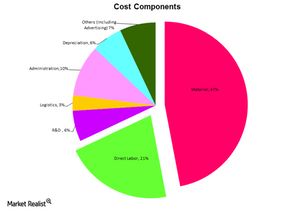Raw materials – the biggest cost driver in the auto industry
Raw materials contribute about 47% to the cost of a vehicle. On average, an automobile is 47% steel, 8% iron, 8% plastic, 7% aluminum, and 3% glass.
Feb. 10 2015, Updated 1:06 p.m. ET

Cost components
There are four major cost drivers in the production and sale of an automobile:
- raw materials
- labor
- advertising
- R&D (research and development)
Raw materials contribute about 47% to the cost of a vehicle. On average, an automobile is 47% steel, 8% iron, 8% plastic, 7% aluminum, and 3% glass. Other materials account for the remaining 27%.
Approximately 22% of an automaker’s operational costs depend on steel. So, any fluctuation in global steel prices has a direct impact on profitability. Steel billet prices came down drastically from 15.2 euros per metric ton in 2008 to 4.8 euros per metric ton in 2013. This significantly improved manufacturers’ gross margins. During this period, the gross margins increased by 200 basis points, or bps, from 15.2% to 17.2%.
Traditionally, automakers only used aluminum for wheels, cylinder blocks, and other engine parts. Aluminum is twice as expensive as steel. However, this trend is changing in response to stringent fuel economy standards. The US government’s Corporate Average Fuel Economy, or CAFE, regulations require vehicles to have an average fuel consumption of 34.1 miles per gallon, or mpg, by 2016. Vehicles are required to have an average fuel consumption of 54.5 mpg by 2025.
The shift towards aluminum
Although it’s more expensive than steel, aluminum is much lighter. It has a similar strength. Every 10% reduction in weight improves the fuel economy by 5–7%. Currently, due to cost constraints, only Premium segment cars—like Tata Motors’ (TTM) Jaguar XF and the Audi (AUDVF) A8—have aluminum bodies.
The new Ford (F) F-150 will launch in January 2015. It will have a high proportion of aluminum in its makeup. Toyota (TM) also said it will be using aluminum in the future for hoods, closures, and parts to make cars lightweight.
Investors can gain exposure to the auto industry through the Consumer Discretionary Select Sector SPDR ETF (XLY). Ford and General Motors account for 2.6% and 2.1% of the fund, respectively.
After raw materials, labor is the biggest cost source for automakers. It’s also the most contentious. In the next part of this series, we’ll focus on labor costs.
